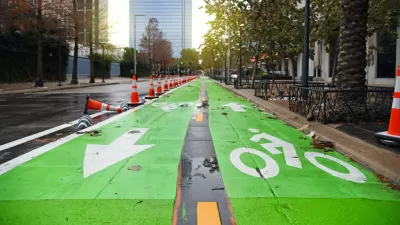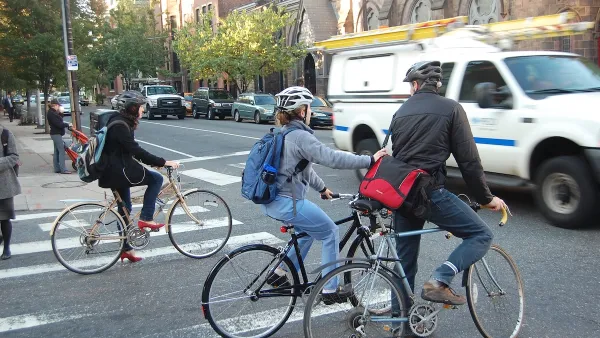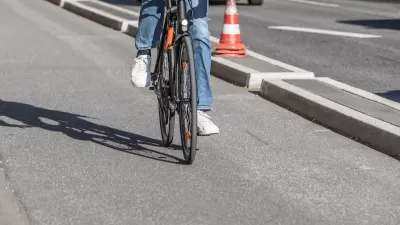Discussing the trade-offs between making government leaner and making traffic safer.

I recently launched my campaign for Borough President of Manhattan; due to a complicated series of events not relevant to this post, I am running with the Libertarian endorsement. Once I start participating in candidate forums (Zoom or otherwise), I expect to be asked about bicycle or pedestrian improvements. In the context of New York City, this usually means taking a lane or two of a major street's space away from cars and giving it to cyclists and pedestrians. For example, Transportation Alternatives proposes using 25 percent of the city's parking and road space for bus lanes, bike lanes, and open space (among other things).
The basic idea underlying libertarianism is that because the use of force by government limits human freedom, government taxation and regulation should be minimized if not eliminated. So, if I were the purest possible libertarian (i.e., an anarchocapitalist, or even an extreme minarchist), I would oppose these policies, since even the smallest intervention is likely to require some public funds; for example, painting a bike lane would involve some expenditure of municipal employees' time and thus of taxpayer money. On the other hand, classical liberals tend to favor a somewhat larger government, and some prominent Libertarian politicians (such as 2016 Presidential nominee Gary Johnson) arguably belong to this group. For example, Johnson opposed abolishing the federal Environmental Protection Agency, which makes him more moderate than some prominent Republicans on this issue.
So could a non-anarchocapitalist favor bike lanes or wider sidewalks? I begin with the assumption that even a minarchist would favor a government that protects us from others' use of force. Obviously, this means that there must be police to arrest predatory criminals, courts to sentence them, and even some form of punishment for crime (such as prisons).
It seems to me that if government is necessary to protect us from intentional use of force, it is also necessary to protect us from others' unintentional use of force. This need not involve criminal justice; the tort system compensates people when they are injured as a result of others' negligence. I doubt that minarchists would favor abolishing civil courts that enforce tort law (or for that matter, common-law contract and property law).
Taking the idea a little further, if "preventing the use of force" includes compensating people who are victimized by others' negligence, this concept could also include preventing such negligence from happening in the first place. It seems to be well documented that where streets are devoted almost exclusively to the use of speeding automobiles, those automobiles create more injuries (i.e. force) than in places where they travel less rapidly. For example, the metro areas with the highest pedestrian death rates are in the South, where streets are built for speed to an even greater extent than in the rest of the United States. On a more local level, narrower streets appear to be less dangerous: a study performed by New York City's Department of Transportation shows that on streets where bicycle lanes were installed, injuries for both motor vehicle occupants and pedestrians decreased by over 20 percent.**
On the other hand, safety is not free. I suspect that placing a police officer on every corner 24 hours a day would probably reduce violent crime (even if some of that reduction was offset by increased police violence). But the tax increases necessary to create this level of police supervision might be unsustainable. Similarly, it would probably be ruinously expensive to make every single New York street only two or three lanes wide, even if the initial widening of those streets was a mistake. Thus, policymakers should weigh the benefits of wider sidewalks and better bike lanes against the costs of creating them, and the difficulty of raising money to pay for them. It seems to me that some money could be raised from relatively non-coercive interventions rather than through broad-based tax increases. For example, as long as streets are publicly owned and maintained, it seems to me reasonable for the city to charge for the use of the city's space—that is, to charge market prices for parking on a government-owned street. So it seems to me that at least some pedestrian and bicycle improvements could be funded relatively painlessly.
*Of course, in a truly minarchist society most streets would be privately owned. I suspect that privately owned streets would create less space for cars and more space for housing and businesses, since housing and businesses would probably pay more rent than motorists. But it seems to me highly unlikely that in modern-day New York, a significant number of streets will be converted to private use.
**In addition, speeding automobiles create other negative externalities such as air and noise pollution. But for the purpose of this blog post, I will limit my discussion to car collisions, because this requires less scientific discussion and is thus a simpler topic.

Maui's Vacation Rental Debate Turns Ugly
Verbal attacks, misinformation campaigns and fistfights plague a high-stakes debate to convert thousands of vacation rentals into long-term housing.

Planetizen Federal Action Tracker
A weekly monitor of how Trump’s orders and actions are impacting planners and planning in America.

San Francisco Suspends Traffic Calming Amidst Record Deaths
Citing “a challenging fiscal landscape,” the city will cease the program on the heels of 42 traffic deaths, including 24 pedestrians.

Defunct Pittsburgh Power Plant to Become Residential Tower
A decommissioned steam heat plant will be redeveloped into almost 100 affordable housing units.

Trump Prompts Restructuring of Transportation Research Board in “Unprecedented Overreach”
The TRB has eliminated more than half of its committees including those focused on climate, equity, and cities.

Amtrak Rolls Out New Orleans to Alabama “Mardi Gras” Train
The new service will operate morning and evening departures between Mobile and New Orleans.
Urban Design for Planners 1: Software Tools
This six-course series explores essential urban design concepts using open source software and equips planners with the tools they need to participate fully in the urban design process.
Planning for Universal Design
Learn the tools for implementing Universal Design in planning regulations.
Heyer Gruel & Associates PA
JM Goldson LLC
Custer County Colorado
City of Camden Redevelopment Agency
City of Astoria
Transportation Research & Education Center (TREC) at Portland State University
Jefferson Parish Government
Camden Redevelopment Agency
City of Claremont






























